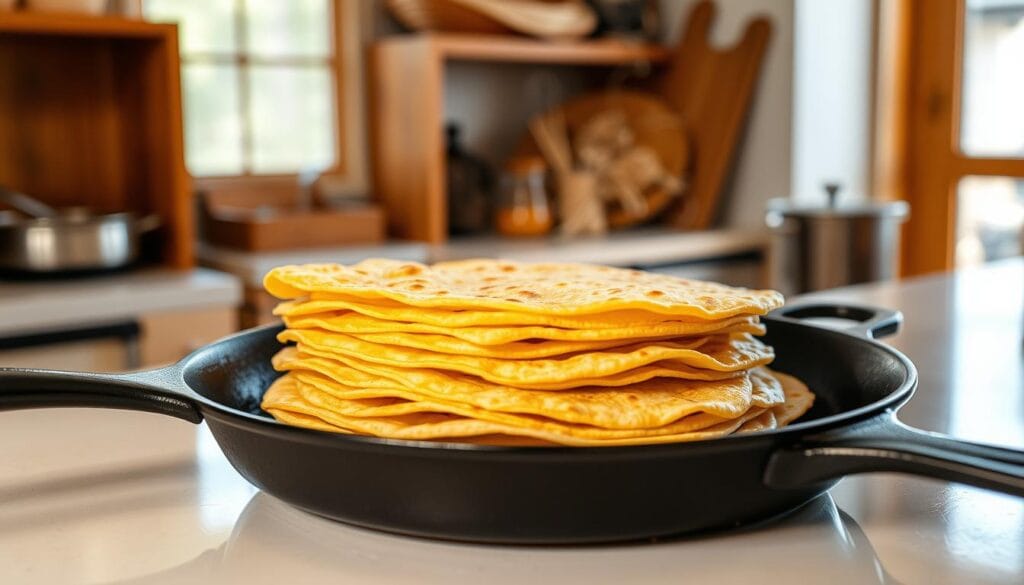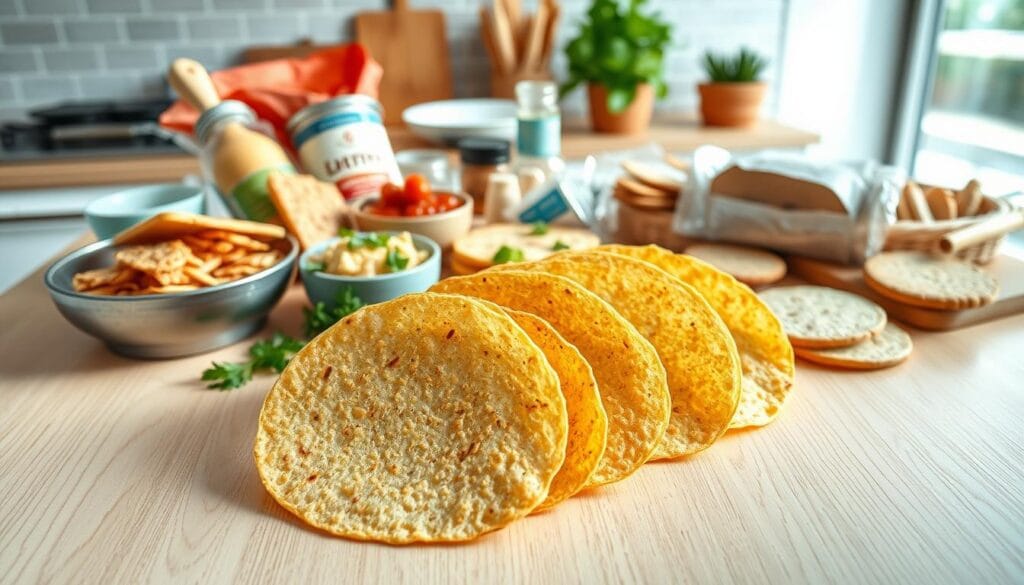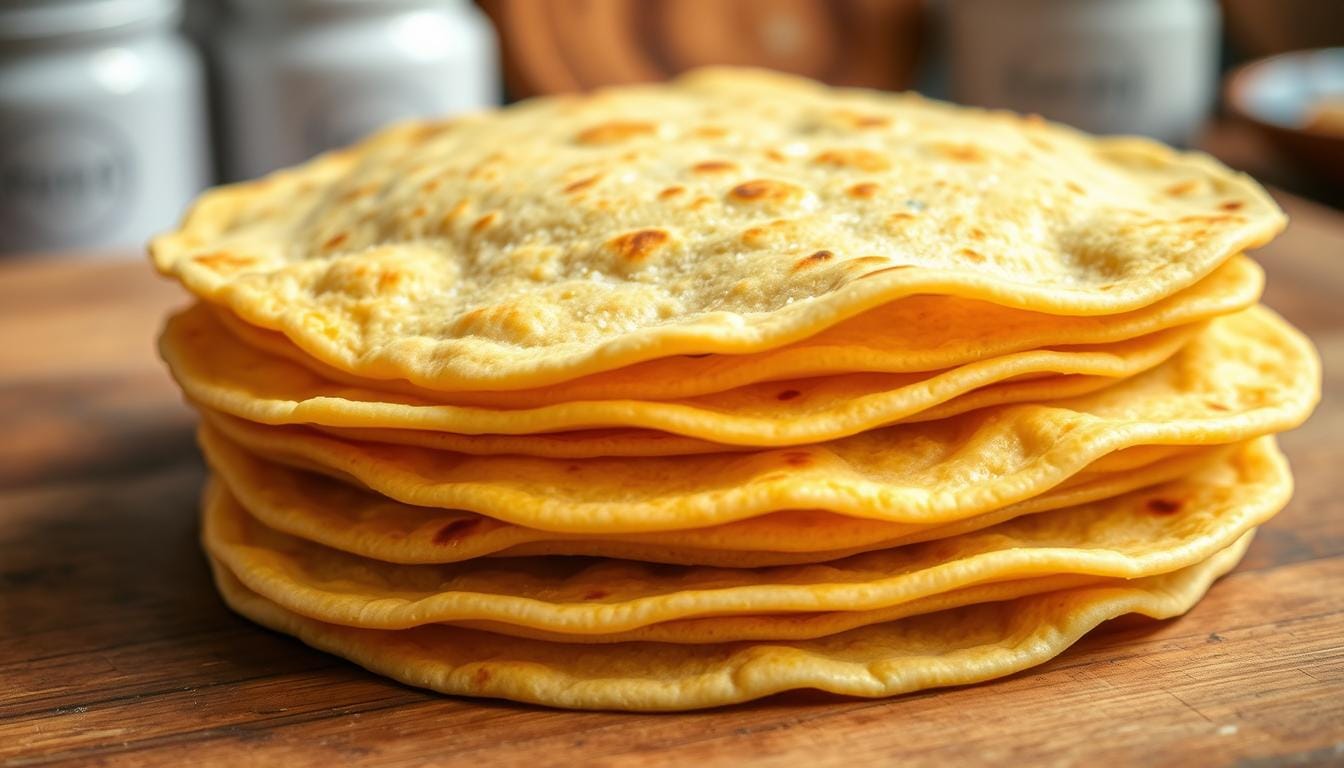When you think about a gluten-free diet, you might ask if are corn tortillas gluten free. About 13% of the world’s people are gluten sensitive. It’s key to know what’s in corn tortillas. Corn tortillas are naturally gluten-free, but they might get contaminated with gluten if made in the same place as wheat products. Always check the label for gluten-free corn tortillas.
It’s important to know what you eat when you’re on a gluten-free diet. Corn tortillas can be a good choice, but make sure they’re gluten-free. In this guide, we’ll look into gluten-free corn tortillas. We’ll give you the info you need to make smart choices.
Introduction to Gluten-Free Corn Tortillas
Corn tortillas are full of dietary fiber. They also have important nutrients like calcium, potassium, magnesium, and phosphorus. They’re a good pick for a gluten-free diet. But, people with diabetes or blood sugar issues should eat them in small amounts because of their carbs.
Key Takeaways
- Corn tortillas are naturally gluten-free, but cross-contamination can occur.
- Checking the label for gluten free corn tortillas is crucial.
- Corn tortillas are a good source of dietary fiber and essential nutrients.
- Individuals with diabetes or blood sugar concerns should consume corn tortillas in moderation.
- Corn tortillas can be a great option for a gluten-free diet.
- Always check the label to ensure the corn tortillas you choose are gluten-free.
Understanding Corn Tortillas and Gluten
Corn tortillas are a key part of Mexican and Latin American food. They are made from masa harina, salt, and water. This makes them naturally gluten free.
Gluten is a protein in wheat, barley, and rye. It can cause problems for people with celiac disease. Corn, on the other hand, is gluten free. But, some corn tortillas might have gluten from cross-contamination or added ingredients.
To find gluten free tortillas, always check the labels. Look for certifications from trusted organizations. Many brands now offer gluten free corn tortillas. This makes it easier to follow a gluten free diet.
- Corn tortillas are typically made from masa harina, salt, and water.
- Wheat tortillas are made from wheat flour, water, and often contain gluten.
- Corn tortillas are generally lower in calories and higher in fiber compared to wheat tortillas.
Knowing what corn tortillas are made of helps you make better diet choices. You can enjoy the benefits of gluten free tortillas.
The Truth About Are Corn Tortillas Gluten Free
Corn tortillas are a key part of many cuisines, especially in Mexican and Latin American cooking. Many people ask if corn tortillas are gluten free. The answer is yes, if they are made from 100% corn flour and don’t have gluten.
But, some brands might add wheat flour for texture. This can add gluten. So, it’s important to check the label for gluten free corn tortillas. People with gluten issues should only choose tortillas labeled ‘gluten-free’ to be sure they are safe.
When looking for are corn tortillas gluten free, always read the labels. Some tortillas might be made in places where gluten is present. To stay safe, choose gluten free corn tortillas from trusted brands that follow strict gluten-free rules.
In short, corn tortillas can be a good choice for those on a gluten free diet. Just make sure they are 100% corn flour and gluten-free. Always check the label and look for gluten-free certifications.
| Type of Tortilla | Gluten-Free Status |
|---|---|
| Traditional Corn Tortilla | Gluten-Free |
| Store-Bought Corn Tortilla | May Contain Gluten |
| Gluten-Free Corn Tortilla | Gluten-Free |
Essential Ingredients in Authentic Corn Tortillas
Making authentic corn tortillas is simple yet important. You need masa harina, water, and salt. The making of masa harina involves nixtamalizing corn. This gives corn tortillas their special texture and taste.
This traditional method has been used for centuries. It helps keep corn’s natural nutrients.
Masa harina makes authentic corn tortillas stand out. It’s a great choice for those who want gluten free tortillas. The nixtamalization process makes corn easier to grind and boosts its nutrient value.
- Masa harina is the main ingredient and gives the tortilla its shape.
- Water mixes with masa harina to make a dough that’s easy to work with.
- Salt adds flavor to the tortillas.
Together, these ingredients and the nixtamalization process create gluten free tortillas. They are tasty, nutritious, and full of history.
Cross-Contamination Risks in Corn Tortilla Production
Producing gluten free corn tortillas is a big deal because of cross-contamination risks. Web sources say cross-contamination can happen if the same equipment is used for gluten and gluten-free products. This is because of shared facilities or not cleaning equipment well enough. So, it’s crucial for manufacturers to follow strict rules to avoid cross-contamination and ensure their products are safe.
Manufacturers can reduce cross-contamination risks by following strict quality control steps. This includes cleaning equipment often, keeping gluten and gluten-free ingredients separate, and labeling products clearly. Consumers can also help by choosing products from trusted brands and checking labels for certifications like the Gluten-Free Certification Organization (GFCO) or the Celiac Support Association (CSA).
Some important stats to think about when looking at cross-contamination risks in corn tortilla making are:
- 16% of tested corn flour samples had more than 20 ppm of gluten, which is not safe for celiac disease patients.
- Cornstarch is low risk for cross-contamination because it’s highly processed and used in small amounts in gluten-free baking.
- A study showed that gluten-free foods can be made safely with wheat-based flours in shared kitchens if the right steps are taken.
By knowing the risks of cross-contamination and taking steps to lower them, people can enjoy gluten free corn tortillas safely. Whether you need to follow a gluten free diet for health reasons or just prefer it, making sure your food is safe and of good quality is key.
Reading Corn Tortilla Labels: What to Look For
When you buy gluten free corn tortillas, it’s key to check the label. Look for certification symbols from trusted groups like the Gluten-Free Certification Organization (GFCO) or the Celiac Support Association (CSA). These symbols show the product has been tested and meets standards.
Also, scan the ingredient list for gluten sources. Some tortillas might have wheat flour, which isn’t gluten-free. Choose gluten free brands known for their quality and safety.
Brands like Mission, Pueblo, and La Tortilla Factory are well-known for their gluten-free corn tortillas. They use top-notch ingredients and avoid common allergens. By picking a trusted brand and reading labels, you can enjoy tasty and safe gluten free corn tortillas in your meals.
Nutritional Benefits of Corn Tortillas
Corn tortillas are great for a gluten free diet. They are full of fiber, vitamins, and minerals. This makes them a top pick for better health. A single tortilla has about 50-60 calories, which is low.
They are packed with nutrients like calcium, potassium, magnesium, and phosphorus. Corn tortillas also have a lot of dietary fiber. This helps with digestion and keeps you feeling full. Plus, they are low in sodium and fat, which is good for those watching their fat intake.
Some of the key benefits of corn tortillas include:
- High in fiber and low in calories
- Rich in essential nutrients like calcium, potassium, and magnesium
- Naturally low in sodium and fat
- Can be a good source of whole grains, which can improve heart health
Overall, corn tortillas are a healthy choice for a gluten free diet. They offer many nutritional benefits and support overall health and well-being.
Making Gluten-Free Corn Tortillas at Home
With just a few ingredients and basic tools, you can make tasty gluten-free corn tortillas at home. These tortillas are great for those on a gluten-free diet. You’ll need 2 cups of masa harina, 1⅓ cups of water, and a pinch of salt. Look for Maseca masa harina in Latin American or specialty shops.
This recipe makes about 12-16 tortillas, with each one having about 69 calories. To start, mix the masa harina and water in a bowl until a dough forms. If it’s too dry, add a little more water, 1 tablespoon at a time. Then, use a tortilla press or a rolling pin to shape the dough.
Here are some tips for making gluten-free corn tortillas at home:
- Choose the right masa harina, made from nixtamalized corn, for the best texture and flavor.
- Use warm water to help the dough come together.
- Avoid overworking the dough to prevent tough tortillas.
- Cook the tortillas in a nonstick skillet for about 30-45 seconds on each side.
By following these steps, you can make delicious gluten-free corn tortillas at home. They’re perfect for your favorite toppings or fillings. Making your own tortillas is a fun and rewarding process. So, why not try making your own gluten-free corn tortillas at home?
Storing and Preserving Your Corn Tortillas
To keep your corn tortillas fresh, it’s key to store and preserve them right. You can freeze, refrigerate, or dry them. Freezing is great because it keeps their texture and taste. Store them in airtight containers or bags, removing air to avoid freezer burn.
Refrigerating is good for a short time. Keep them in the fridge for up to a week, wrapped in plastic or foil. Drying is another choice, especially for longer use. Dry them in the oven or a dehydrator, then store in containers.
It’s important to keep your corn tortillas gluten-free. This means storing them away from gluten products. Use separate containers and tools to avoid contamination. This way, you can enjoy your tortillas while sticking to a gluten-free diet.
Always check the expiration date and keep them in a cool, dry spot. With the right storage, you can enjoy your corn tortillas longer. They’re perfect for a gluten-free diet or just to keep them fresh.
Best Ways to Heat and Serve Corn Tortillas
There are many ways to heat corn tortillas, each with its own benefits. Whether you’re on a gluten free diet or just want to enjoy tortillas the right way, knowing how to heat and serve them is key. You can use traditional Mexican methods or modern techniques to heat your tortillas. Serving them right is just as important as heating.
To heat corn tortillas, you can use a dry skillet, the oven, or the microwave. For a dry skillet, heat the tortillas for 15-30 seconds on each side. In the oven, broil them for 2 minutes, until they start to show toasted spots. If you’re using the microwave, heat stacks of tortillas with a damp paper towel for 20 seconds. These methods are all good for heating tortillas on a gluten free diet.
Here are some key tips for heating and serving corn tortillas:
- Heat corn tortillas for 15-30 seconds on each side in a dry skillet
- Broil corn tortillas in the oven for 2 minutes, or until toasted spots appear
- Use the microwave to heat stacks of corn tortillas for 20 seconds
- Serve corn tortillas warm, with your favorite fillings and toppings
By following these tips and choosing the right heating method, you can enjoy delicious corn tortillas on a gluten free diet. Always check the temperature and cooking time to make sure your tortillas are perfectly heated. With a bit of practice, you’ll be great at heating and serving corn tortillas, making them a wonderful option for a gluten free diet.

| Nutrient | Amount |
|---|---|
| Calories | 170 kcal |
| Carbohydrates | 35 g |
| Protein | 4 g |
| Total fat | 2 g |
Health Considerations for Celiac Disease Patients
For those with celiac disease, sticking to a gluten free diet is key. It’s known that about 1 in 100 people worldwide have this condition. The only way to treat it is with a 100% gluten-free diet.
It’s important for celiac disease patients to watch out for cross-contamination. Even a small amount of gluten can cause problems. Things like shared kitchen tools and condiment jars can be sources of contamination. A well-thought-out gluten free diet can help avoid these issues and keep you healthy.
Some important health considerations for celiac disease patients include:
- Regular blood tests to check for deficiencies, particularly for iron and vitamin B12
- Regular follow-ups with healthcare providers, especially after diagnosis and annually thereafter
- Awareness of high-risk foods that may contain gluten, such as regular oats and gluten-free grains (except rice)
By knowing these health considerations and sticking to a strict gluten free diet, people with celiac disease can manage their condition well. It’s crucial to be mindful of risks and take steps to keep your diet healthy and balanced.
Popular Dishes Using Gluten-Free Corn Tortillas
Gluten-free corn tortillas are key in many traditional Mexican recipes. They are versatile and perfect for making tacos, enchiladas, and more. Enjoy your favorite dishes without gluten worries.
Some popular dishes that use gluten-free corn tortillas include:
- Tacos al pastor, made with marinated pork, onions, and cilantro
- Enchiladas rojas, filled with shredded chicken and covered in a spicy tomato sauce
- Chiles rellenos, stuffed peppers filled with cheese, meat, or vegetables
These dishes are not only tasty but also easy to make. You can swap gluten-containing ingredients for gluten-free corn tortillas. Get creative and make your own gluten-free versions.
Gluten-free corn tortillas are great for modern fusion dishes too. Try making Korean-Mexican fusion tacos or vegan enchiladas. The options are endless, and you can enjoy many flavors and textures without gluten.
| Dish | Ingredients | Cooking Time |
|---|---|---|
| Tacos al pastor | Gluten-free corn tortillas, marinated pork, onions, cilantro | 20-25 minutes |
| Enchiladas rojas | Gluten-free corn tortillas, shredded chicken, tomato sauce, cheese | 25-30 minutes |
| Chiles rellenos | Gluten-free corn tortillas, stuffed peppers, cheese, meat, or vegetables | 30-35 minutes |
Comparing Corn Tortillas to Other Gluten-Free Alternatives
There are many gluten-free options, including corn tortillas. You might wonder how they stack up against others like rice or quinoa tortillas. We’ll look at the good and bad of each, helping you choose the right one for you.
A comparison shows each gluten-free option has its own traits. Rice tortillas might be lower in calories but higher in carbs. Quinoa tortillas, however, are packed with protein and fiber, appealing to health enthusiasts.
Some top gluten free alternatives to corn tortillas are:
- Rice tortillas
- Quinoa tortillas
- Cauliflower tortillas
Each has its pros and cons, and the best for you depends on your needs and likes.

In summary, while corn tortillas are a favorite for gluten-free seekers, they’re not the only game in town. By weighing the pluses and minuses of each, you can pick the best one for you. Always check the ingredients to make sure it fits your diet.
Common Myths About Corn Tortillas and Gluten
Corn tortillas are naturally gluten-free, making them safe for those on a gluten-free diet. But, there are many myths and misconceptions about corn tortillas and gluten. These need to be cleared up.
Many think all corn tortillas are gluten-free. While mostly true, it’s key to watch out for cross-contamination. Look for brands that are clearly labeled as gluten-free to be sure.
Some believe gluten is only in wheat. But, gluten is also in barley and rye. Knowing this helps you make better food choices, like choosing corn tortillas.
Science backs up that corn tortillas are gluten-free. Many studies show corn is safe and healthy for those with gluten issues.
FAQ
Are corn tortillas gluten-free?
What is the difference between corn and wheat tortillas?
How can I identify gluten-free corn tortillas?
What are the key ingredients in authentic corn tortillas?
How can cross-contamination affect the gluten-free status of corn tortillas?
What should I look for on the label to ensure corn tortillas are gluten-free?
What are the nutritional benefits of corn tortillas?
How can I make gluten-free corn tortillas at home?
How can I store and preserve my corn tortillas?
What are the health considerations for celiac disease patients when it comes to corn tortillas?
What are some popular dishes that use gluten-free corn tortillas?
How do corn tortillas compare to other gluten-free alternatives?
What are some common myths about corn tortillas and gluten?
Table of Contents
Did you like this recipe?
There are no reviews yet. Be the first one to write one.

